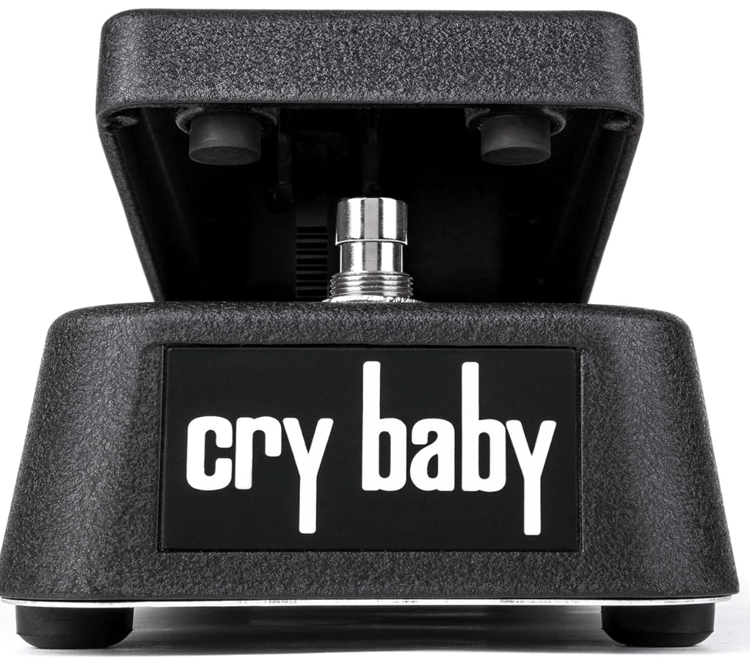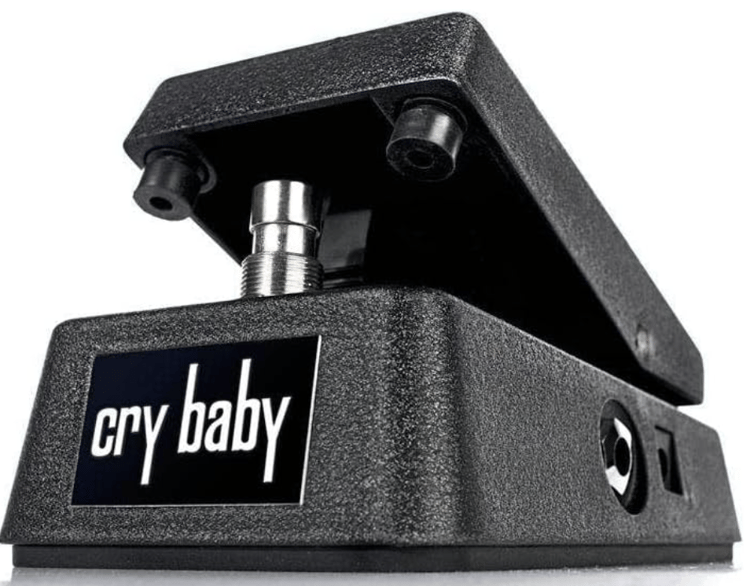In today’s lesson, we will learn how to use a wah pedal to enhance your guitar playing. One of the most iconic guitar effects pedals to ever be invented (besides the overdrive pedal) is the Wah pedal. Especially the Dunlop Crybaby Wah Pedal. This pedal has been hailed by professionals & hobbyists throughout the world since its creation back in the 1980s.

When the wah pedal was invented
But the wah pedal was originally invented by Bradley J Plunkett back in November of 1966. Bradley worked at the Thomas Organ Co. and used a VOX organ pedal to create it. Later he would work with Del Casher, who would take the idea a step further.
Del worked on the pedal in his studio in his Hollywood Hills garage like a mad scientist working on a secret formula. The “sonic sound” he created became popular with musicians who were looking for an edge in expressing their music. Since it was a bit edgy in its design and tone, it was hard to get out to the mainstream.
Guitar heroes use the wah pedal
Then came along artists like Jimi Hendrix, Eric Clapton & Jimi Page who got the pedal & created guitar wizardry with it. Squeals & swoops of sound would seem to just pour out of their guitar as they rocked back and forth with such swag & style.
Effortlessly, as if commanding a spirit from another world! This made the wah popular among guitarists of all kinds who felt it would be an excellent addition to their guitar-playing arsenal.
With this pedal, you could mimic a muted trumpet sound and when played through a high-gain amp as Hendrix did, you could get some sounds that were out of this world. I highly suggest you pick one up & add it to your guitar player toolbox. It will inspire your abilities to enhance like they never have before.
Throughout the years
Over the years, other pedals were made for guitar players who were now able to create total originality in their sound by mixing and matching pedals. Including the wah.
But throughout the years, the sound quality could never really be captured consistently (as each pedal sounded a bit different) until one man stepped into the picture and changed the history of the pedal forever. Mr. Jim Dunlop.
In the 1980’s Jim Dunlop, a machinist who made his style of guitar accessories such as picks, capos & slides was able to acquire the crybaby brand and decided to work on making improvements to this fantastic technology. The ability of someone to see an opportunity & make it work is one of the key elements to any success. Jim Dunlop was no exception.
No giving up
Although it wasn’t an easy transition with technical & logistical hurdles to overcome, Jim wasn’t going to give up. He assembled a state-of-the-art engineering team and purchased the highest-quality components from vendors.
Then methodically took the pedal to a whole new level of consistency and reliability. By doing so, he created the Dunlop Crybaby Wah (that is still, after all these years) sought after by professionals & hobbyists alike.
The Dunlop Crybaby Wah
The Dunlop Crybaby Wah has a very distinctive style & sound. When you hear it, you know it’s a wah. And not just a wah, but the Jim Dunlop Crybaby Wah. This pedal has been used by some of the most popular recording artists, played on stage by the most iconic guitar heroes & utilized on songs that have become the soundtrack to our lives.
This is one of the few pedals that are not only used by guitarists but also by keyboardists & violinists. I know, crazy, huh? I can just imagine a violin with a wah. Does Jimmy Page come to mind? What an awesome guitarist!
Listen for the wah in songs
Listen to how he utilizes the wah in his song “Dazed & Confused“. After hearing that, how could you not want to plug into one and check it out? Do you know what I mean?
Or how about when Eric Clapton uses it in “White Room” with Cream to get that crazy wild sound that sends shivers up & down your spine? Or how about when Jimi Hendrix uses it to maximum effect in the infamous song “Voodoo Child,” where the intro alone grabs you by the “you know what” and slams you to the ground?
Different styles of music
Use the wah pedal in all kinds of different styles of music. Like Pop, Reggae, & Funk. Very popular in funk music. When you hear that wank-wank sound that’s popular in that style, it’s the wah.
And probably a Dunlop Crybaby Wah. So is this a special product? You bet it is! And that my friend is why it is on my pedalboard and is highly recommended, you have it on yours.
When you can create something that is part of people’s everyday lives, you know you have created something special. The Dunlop Crybaby Wah fits into this category.
Used by millions
Millions of people around the world use this pedal & like I always say, “If it’s good enough for all our rock 'n roll heroes who use it (Stevie Ray & countless others), then it should be good enough for us.”
Dunlop makes all kinds of great products for guitars. From pedals to picks, polishes, slides, capos, and more. If you aren’t already using their products, I suggest you check them out.
Not to mention what Jim Dunlop did for the guitar pick, capo & slide. Pretty interesting stuff. But that will have to be for another lesson.
How Does The Crybaby Wah Work?
It works by stepping on it & rocking it back and forth in a sweeping motion. This produces a treble sound when rocked forward and a lower tine when rocked back. It can be used for both rhythm and lead guitar playing.
Watch the video lesson below
Some Technical Aspects of the Dunlop Crybaby Wah
Jim Dunlop created the first GCb95 Crybaby wah pedal in the late ’80s. Designed to replicate the original from the ’60s. But with better sound quality, consistency & reliability.
Thomas Organ Co. were the pioneers of the wah, but unfortunately, they failed to patent their technology & the wah-wah name. Which caused many replicas to flood the market while their model was starting to finally take off. This was unfortunate because it created much competition for the company.
The Dunlop GCb95. This guitar pedal became the first to produce crispier funky rhythms, a cleaner signal that did not distort the original guitar tone, and reliability not to break down.

Professional durability
No matter if you were on the road, stage, or studio. A working musician's kind of pedal that he or she could rely on to give them the signature Crybaby sound night after night consistently.
The Dunlop Crybaby Wah does exactly that! Made up of heavy-duty construction fit for a tank. A nice long shape that is designed to rest your foot on while rocking back & forth, and is powered up by using a 9V battery or a Jim Dunlop AC adapter.
Inside the heavy-duty construction is a circuit setup branching into four compartments. These four blocks consist of a power supply circuit, an input buffer, an output stage, and an active filter. The Thomas Organ Company used a similar setup to create the VOX V847. The only problem with the VOX guitar pedal is that it had a glitch in tonal variation.
A much more controlled sound
When Jim Dunlop took over, he found a way to correct the low input impedance issue by raising the input voltage. This allowed for a much cleaner, more controlled sound.
Over the years the crybaby wah has been redesigned, features added on sister models & a couple of years back Dunlop made some upgrades to the original.
Cosmetic changes to boost its ergonomics and tweaks to the battery compartment to make it more accessible. Which makes it easier to change the battery without interfering with the rubber footing.
The Good Points
A solid metallic casing that is durable and resistant to damage
Produces funky wah-wah sounds iconic with the ’60s, ’70s, & '80s
Does not distort the original tones of the guitar
Improved design for easy access to the battery compartment
Revamped bypass switch to curb the loss of tones
Universal power jack that is compatible with all power supply units
The Bad Points
Lacks LED backlighting to improve visibility in the dark
A bit heavy compared to other pedals.
Needs oversized space on your pedalboard
The mini-wah pedal
That is why the “mini-wah” was invented. For easier transportation & less space taken up on the pedalboard. The Led light thing I believe they are still working on. LOL!! I’ll admit, it does help to see as much as possible when you’re playing in a dark venue.

Guitar players have enough to worry about; no need to make it harder by trying to determine where the wah pedal is when you need to step on it. But then again, if it doesn’t hinder Slash’s playing when he’s all drunk (or at least used to be), it shouldn’t hinder ours. LOL!!!
I will have to say though, I did see GNR over the summer of 2017 and I must admit they still got it! Slash played & sounded KILLER so did Axle & the whole band.
A regular or mini wah is good
I think for the sound quality, consistency, reliability & price range you’re not going to go wrong with either the original Dunlop Crybaby Wah or the “Mini” Dunlop Crybaby Wah. The wah pedal has been around since the ’60s.
The Dunlop Crybaby Wah has been around since the ’80s and is still as popular today as it ever was. Still used by millions to help create musical masterpieces & proudly will be as long as there is electricity to plug an electric guitar into.
It can provide musical inspiration
No matter your style, if you are looking for a new sound, or a new pedal to boost your inspiration, I recommend you check out the Dunlop Crybaby Wah pedal. Or if you are tight on space and need something smaller on your pedalboard.
Or just want to use one pedal real quick, be sure to check out the mini Dunlop wah pedal. The “mini-me” of its bigger brother. This can be very useful in tight spaces.
Advance your learning
If more help is needed with your guitar playing in any areas, such as getting started, playing rhythm, or mastering guitar solos, grab one of my guitar method books to help improve your guitar playing.
Guitar method books

They are currently selling on Amazon in both Kindle and print formats. You will be able to learn guitar easily with these books as they are designed in a simple step-by-step format. That will get you quick results. With plenty of pictures and diagrams for easier understanding.
Additional help available
Best of all, if you purchase these books and need personal assistance, I will be happy to help you at no additional cost. Just contact me at my website, and I will be at your service. With me in your corner, you are sure to reach guitar-playing success.
Keep practicing until our next lesson. Take care.
Sincerely, Dwayne Jenkins


